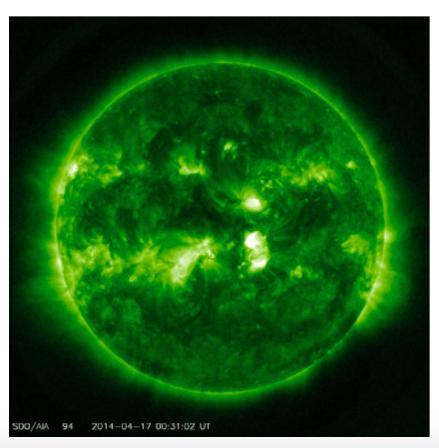A model will help to understand the solar dynamics

This is an image in the solar corona at 171 A. Credit: Solar Dynamic Observatory (SDO)
Plasma β is an important quantity to investigate the interchanging roles of plasma and magnetic pressure in the solar atmosphere. It relates to both the solar magnetic field and driving solar phenomena such as solar wind, coronal mass ejections, and flares; these phenomena affect the Space Weather directly.
Dr. Jenny Rodriguez, a scientist from the Space Center of Skolkovo Institute of Science and Technology (Russia), her colleagues from Leibniz Institut für Sonnenphysik (Germany) and Instituto Nacional de Pesquisas Espaciais (Brazil) have developed a model to estimate how plasma β changes in the solar atmosphere.
Specifically, they obtain a description of the plasma β in the solar corona during previous solar cycles (~22 years). They found the strongest influence during both solar cycles from faculae and the quiet Sun regions.
The faculae and QS regions drive variations in magnetic and kinetic pressure at coronal heights. It can directly affect space weather and the ability to predict it. These results give an interesting outlook on solar cycle dynamics.
“Plasma β is a very important quantity in the solar atmosphere. The solar atmosphere is a plasma physics laboratory near us; it allows us to know about its dynamics and to understand how many events are happening on the Sun. We believe that our findings will help comprehend the Sun's dynamics and help to forecast the Space Weather,” said Dr. Jenny Rodriguez.
Media Contact
All latest news from the category: Physics and Astronomy
This area deals with the fundamental laws and building blocks of nature and how they interact, the properties and the behavior of matter, and research into space and time and their structures.
innovations-report provides in-depth reports and articles on subjects such as astrophysics, laser technologies, nuclear, quantum, particle and solid-state physics, nanotechnologies, planetary research and findings (Mars, Venus) and developments related to the Hubble Telescope.
Newest articles

High-energy-density aqueous battery based on halogen multi-electron transfer
Traditional non-aqueous lithium-ion batteries have a high energy density, but their safety is compromised due to the flammable organic electrolytes they utilize. Aqueous batteries use water as the solvent for…

First-ever combined heart pump and pig kidney transplant
…gives new hope to patient with terminal illness. Surgeons at NYU Langone Health performed the first-ever combined mechanical heart pump and gene-edited pig kidney transplant surgery in a 54-year-old woman…

Biophysics: Testing how well biomarkers work
LMU researchers have developed a method to determine how reliably target proteins can be labeled using super-resolution fluorescence microscopy. Modern microscopy techniques make it possible to examine the inner workings…





















